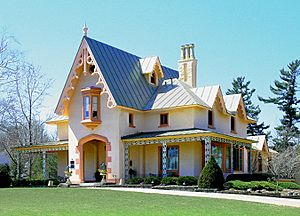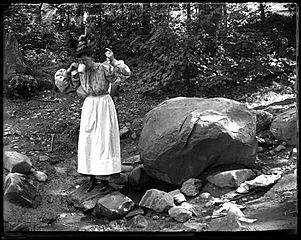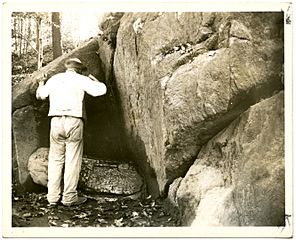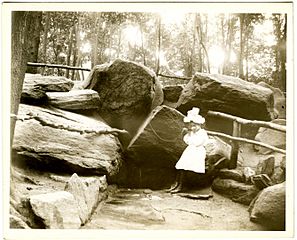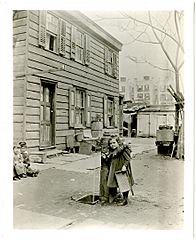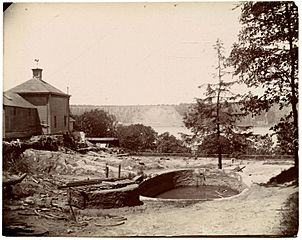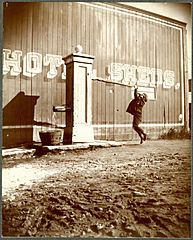James Reuel Smith facts for kids
Quick facts for kids
James Reuel Smith
|
|
|---|---|
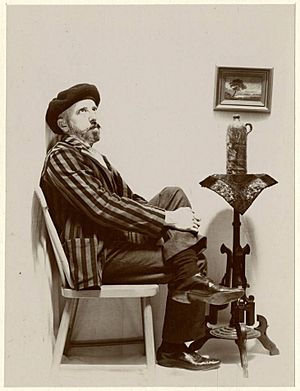
James Reuel Smith, photographic self-portrait, c. 1893–1905
|
|
| Born | 1852 Skaneateles, New York, U.S.
|
| Died | November 12, 1935 (aged 82–83) Yonkers, New York, U.S.
|
| Known for | documentary photography |
| Spouse(s) | Elizabeth Thompson |
James Reuel Smith (1852–1935) was an American photographer and a historian. He lived during the late 1800s and early 1900s. Smith was known for his documentary photographs of old springs and wells in New York City. He took these pictures before the city grew so much that these natural water sources were covered by concrete. Many of these springs and wells disappeared as the New York municipal water system developed.
Smith's photographs showed a way of life that was vanishing in American cities. Getting water from springs and wells was a daily activity before modern water systems were built. In the 1870s, New York City started to get rid of these natural wells and springs. City officials thought they were bad for people's health. The main source for city water then became the Croton Aqueduct.
Contents
Early Life of James Reuel Smith
Smith was born in Skaneateles, New York, in 1852. He was the older of two sons. His mother, Celestia A. Mills, died five years after she married his father, Reuel Smith. His father was known as "Little Smith." After his mother died, his father remarried, and James was sent to live with a cousin.
His father was a partner in a shipping company called Smith & Mills. This company made a lot of money by shipping rice, sugar, and cotton to England.
Smith's Photography Work
Smith's family had enough money that he could enjoy photography as a hobby. The main things he photographed were the springs and wells of New York City. Between 1897 and 1901, he rode his bicycle all over Manhattan and the Bronx. He found and photographed over 160 wells and springs.
He was very careful and kept detailed notes. He wrote down the condition and exact location of each historical water source. The New York Historical Society said about his photos: "Springs were very important to Mr. Smith. He made careful notes... and he always wanted to publish his findings."
Smith also took some pictures of wells in Brooklyn.
Documenting a Vanishing Way of Life
Smith's photographs helped us understand the visual culture of New York City. They showed a way of life that was disappearing in American cities. The daily task of getting water from wells and springs was a key part of life. This was before the modern city water system was built.
In the 1870s, the city began to remove these old wells and springs. City health officials believed these natural water sources were a risk to health. At that time, the Croton Aqueduct was the official source of water for the city.
Books by Smith
Later, Smith traveled to Europe to photograph springs and wells there. This trip led to his book, Springs and Wells in Greek and Roman Literature, Their Legends and Locations (1922). This book covered many places in Italy and Greece. It also included other countries in Europe, Africa, and the Middle East.
Smith's photos of New York's natural water sources were not shown to the public until after he died. His book, Springs and Wells of Manhattan and the Bronx, New York City at the End of the 19th Century, was published in 1938. Smith wrote the introduction to this book before he passed away. He wrote: "In the days, not so very long ago... nothing was more cheering to the thirsty city tourist... than to discover a natural spring of clear cold water, and nothing quite so refreshing as a draught of it."
Smith also wrote technical articles about photography.
Personal Life
Smith married Elizabeth Thompson in 1882. They did not have any children. After his father died in 1873, Smith's younger brother, Edmund Reuel Smith, inherited the family's summer home. This home was the Reuel E. Smith House in Skaneateles, New York.
James Reuel Smith died at his home in Yonkers, New York, on November 12, 1935.
Where Smith's Work is Kept
His photographs are part of the permanent collection at the New York Historical Society. The James Reuel Smith Springs and Wells Photograph Collection has 17 boxes of materials. This includes seven boxes of glass negatives and also acetate negatives. His work is also kept at the Library of Congress.
Smith's Legacy
When Smith died, his estate was worth a lot of money. In 1938, it was worth about $328,383. This would be about $6 million in today's money (2021). He gave 20 shares of his money, about $100,000 in 1938, to the U.S. government.
He gave the rest of his money to several groups. These included the American Museum of Natural History, the New York Children's Aid Society, and Children's Village Inc. He also gave money to the Bide-a-Wee Home Association. This is a "no kill" animal shelter and pet cemetery.
Artists Inspired by Smith
The work of James Reuel Smith has inspired several modern artists. They have created art in response to Smith's photography projects. For example, Jimbo Blachly made an art piece called About 86 Springs in 2003. It was at SculptureCenter in Long Island City, New York.
Another photographer, Stanley Greenberg, started a project to re-photograph all the well and spring sites in Manhattan and the Bronx. These photos were published in his 2021 book, Springs and Wells – Manhattan and the Bronx: Stanley Greenberg.
Gallery


